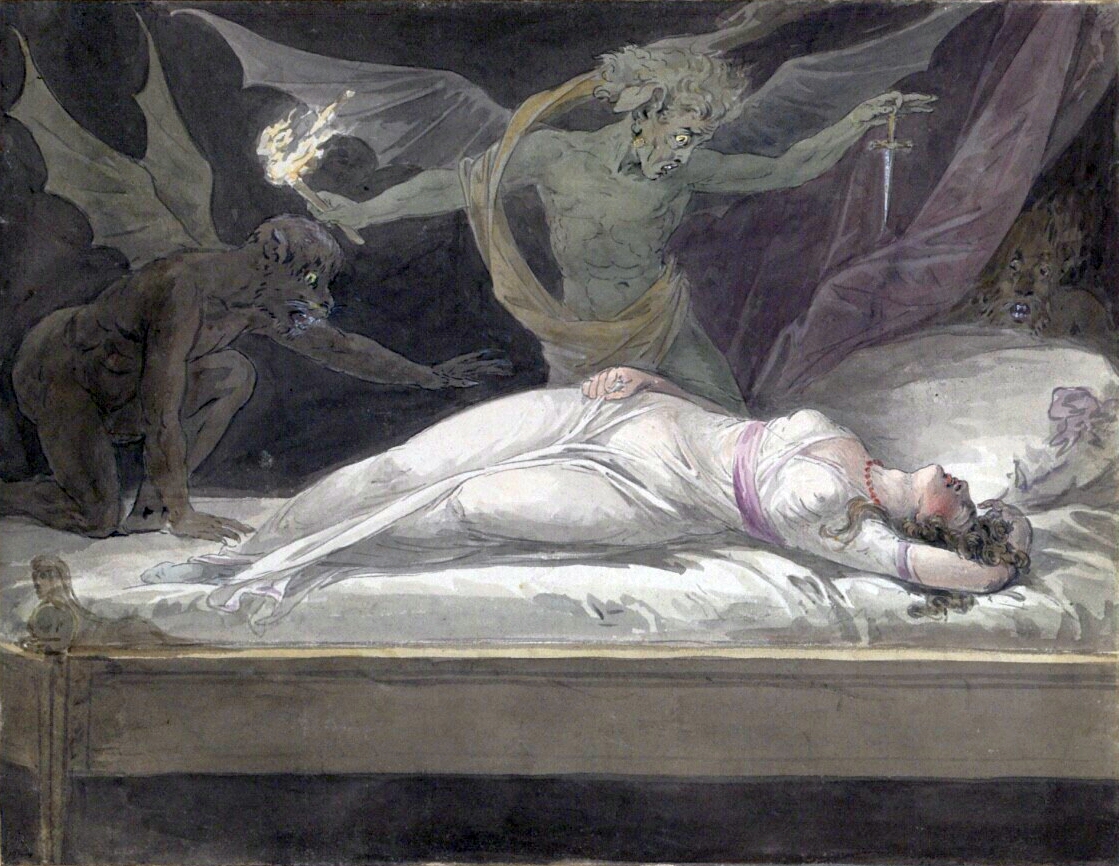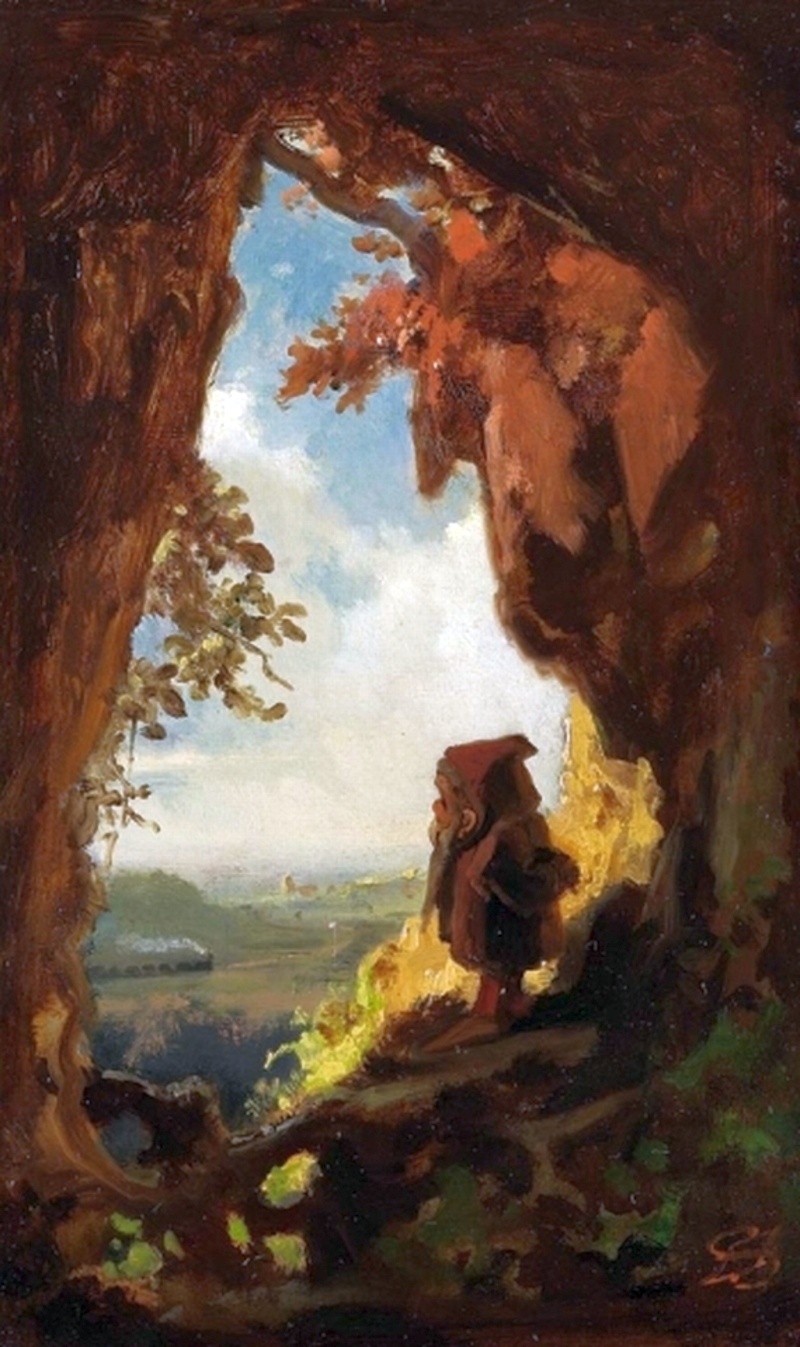|
Schrat
The ''Schrat'' () or ''Schratt'', also ''Schraz'' or ''Waldschrat'' (forest ''Schrat''), is a rather diverse German folklore, German and Slavic mythology, Slavic legendary creature with aspects of either a wild man, wood sprite, Household deity, domestic sprite and a nightmare Mare (folklore), demon. In other languages it is further known as ''Skrat''. Etymology The word ''Schrat'' originates in the cognate, same word root as Old Norse ''skrati'', ''skratti'' (sorcerer, giant), Icelandic language, Icelandic ' (devil) and ''vatnskratti'' (water sprite), Swedish language, Swedish ' (fool, sorcerer, devil), and English language, English ' (devil). The German term entered Slavic languages and (via North Germanic languages) Finno-Ugric languages, Finno-Ugric ones as well. Examples are Polish language, Polish ''skrzat'', ''skrzot'' (domestic sprite, dwarf), Czech language, Czech (domestic sprite, gold bringing devil/gnome, mining sprite), Slovene language, Slovene (domestic sprit ... [...More Info...] [...Related Items...] OR: [Wikipedia] [Google] [Baidu] |
German Folklore
German folklore is the folk tradition which has developed in Germany over a number of centuries. Seeing as Germany was divided into numerous polities for most of its history, this term might both refer to the folklore of Germany proper and of all German-speaking countries, this wider definition including folklore of Austria and Liechtenstein as well as the German-speaking parts of Switzerland, Luxembourg, Belgium, and Italy. Characteristics It shares many characteristics with Nordic folklore and English folklore due to their origins in a common Germanic mythology. It reflects a similar mix of influences: a pre-Christian pantheon and other beings equivalent to those of Norse mythology; magical characters (sometimes recognizably pre-Christian) associated with Christian festivals, and various regional 'character' stories. As in Scandinavia, when belief in the old gods disappeared, remnants of the mythos persisted: There are: * Frau Holle or Perchta, a "supernatural" patron o ... [...More Info...] [...Related Items...] OR: [Wikipedia] [Google] [Baidu] |
Incubus
An Incubus () is a demon, male demon in human form in folklore that seeks to have Sexuality in Christian demonology, sexual intercourse with sleeping women; the corresponding spirit in female form is called a succubus. Parallels exist in many cultures. In medieval Europe, union with an incubus was supposed by some to result in the birth of witches, demons, and deformed human offspring. Legendary magician Merlin was said to have been fathered by an incubus. Walter Stephens writes in his book ''Demon Lovers'' that some traditions hold that repeated sexual activity with an incubus or succubus may result in the deterioration of health, an impaired mental state, or even death. Etymological, ancient, and religious descriptions The Late Latin word ''incubus'' ("a nightmare induced by a demon") is derived from Latin ''incubō'' ("nightmare, what lies down on one whilst one sleeps") and further from ''incubāre'' ("to lie upon, to hatch"). One of the earliest evident mentions of a demon ... [...More Info...] [...Related Items...] OR: [Wikipedia] [Google] [Baidu] |
Satyr
In Greek mythology, a satyr (, ), also known as a silenus or ''silenos'' ( ), and sileni (plural), is a male List of nature deities, nature spirit with ears and a tail resembling those of a horse, as well as a permanent, exaggerated erection. Early artistic representations sometimes include horse-like legs, but, by the sixth century BC, they were more often represented with human legs. Comically hideous, they have mane-like hair, bestial faces, and snub noses and they always are shown naked. Satyrs were characterized by their ribaldry and were known as lovers of wine, music, dancing, and women. They were companions of the god Dionysus and were believed to inhabit remote locales, such as woodlands, mountains, and pastures. They often attempted to seduce or rape nymphs and mortal women alike, usually with little success. They are sometimes shown masturbation, masturbating or engaging in bestiality. In classical Athens, satyrs made up the Greek chorus, chorus in a genre of play kn ... [...More Info...] [...Related Items...] OR: [Wikipedia] [Google] [Baidu] |
Faun
The faun (, ; , ) is a half-human and half-goat mythological creature appearing in Greek and Roman mythology. Originally fauns of Roman mythology were ghosts ( genii) of rustic places, lesser versions of their chief, the god Faunus. Before their conflation with Greek satyrs, they and Faunus were represented as naked men (e.g. the Barberini Faun). Later fauns became copies of the satyrs of Greek mythology, who themselves were originally shown as part-horse rather than part-goat. By the Renaissance, fauns were depicted as two-footed creatures with the horns, legs, and tail of a goat and the head, torso, and arms of a human; they are often depicted with pointed ears. These late-form mythological creatures borrowed their look from the satyrs, who in turn borrowed their look from the god Pan of the Greek pantheon. They were symbols of peace and fertility, and their Greek chieftain, Silenus, was a minor deity of Greek mythology. Origins Romans believed fauns stirred fear in m ... [...More Info...] [...Related Items...] OR: [Wikipedia] [Google] [Baidu] |
Middle High German
Middle High German (MHG; or ; , shortened as ''Mhdt.'' or ''Mhd.'') is the term for the form of High German, High German language, German spoken in the High Middle Ages. It is conventionally dated between 1050 and 1350, developing from Old High German (OHG) into Early New High German (ENHG). High German is defined as those varieties of German which were affected by the High German consonant shift, Second Sound Shift; the Middle Low German (MLG) and Middle Dutch languages spoken to the North and North West, which did not participate in this sound change, are not part of MHG. While there is no ''standard'' MHG, the prestige of the Hohenstaufen court gave rise in the late 12th century to a supra-regional literary language () based on Swabian dialect, Swabian, an Alemannic German, Alemannic dialect. This historical interpretation is complicated by the tendency of modern editions of MHG texts to use ''normalised'' spellings based on this variety (usually called "Classical MHG"), which ... [...More Info...] [...Related Items...] OR: [Wikipedia] [Google] [Baidu] |
Old High German
Old High German (OHG; ) is the earliest stage of the German language, conventionally identified as the period from around 500/750 to 1050. Rather than representing a single supra-regional form of German, Old High German encompasses the numerous West Germanic languages, West Germanic dialects that had undergone the set of sound change, consonantal changes called the High German consonant shift, Second Sound Shift. At the start of this period, dialect areas reflected the territories of largely independent tribal kingdoms, but by 788 the conquests of Charlemagne had brought all OHG dialect areas into a single polity. The period also saw the development of a stable linguistic border between German and Gallo-Romance languages, Gallo-Romance, later French language, French. Old High German largely preserved the synthetic language, synthetic inflectional system inherited from its ancestral Germanic forms. The eventual disruption of these patterns, which led to the more analytic language ... [...More Info...] [...Related Items...] OR: [Wikipedia] [Google] [Baidu] |
Medieval
In the history of Europe, the Middle Ages or medieval period lasted approximately from the 5th to the late 15th centuries, similarly to the post-classical period of World history (field), global history. It began with the fall of the Western Roman Empire and transitioned into the Renaissance and the Age of Discovery. The Middle Ages is the middle period of the three traditional divisions of Western history: classical antiquity, the medieval period, and the modern period. The medieval period is itself subdivided into the Early Middle Ages, Early, High Middle Ages, High, and Late Middle Ages. Population decline, counterurbanisation, the collapse of centralised authority, invasions, and mass migrations of tribes, which had begun in late antiquity, continued into the Early Middle Ages. The large-scale movements of the Migration Period, including various Germanic peoples, formed new kingdoms in what remained of the Western Roman Empire. In the 7th century, North Africa and the ... [...More Info...] [...Related Items...] OR: [Wikipedia] [Google] [Baidu] |
Kratt
Kratt (or kratid in plural; also ''pisuhänd'', ''puuk'', ''tulihänd'', ''vedaja''), is a magical creature in old Estonian mythology, a treasure-bearer. A kratt was a creature formed from hay or of old household implements by its master, who then had to give the Devil three drops of blood to bring life to the kratt. The kratt was notable for doing everything the master ordered it to and was mostly used for stealing and bringing various goods for the kratt's owner. It was said to be able to fly around. An interesting aspect of the kratt is that it was necessary for it to constantly keep working, otherwise it would turn dangerous to its owner. Once the kratt became unnecessary, the master of the kratt would ask the creature to do impossible things such as build a ladder from bread, as portrayed in Andrus Kivirähk's ''Rehepapp'' (''The Old Barny''). Impossible tasks took so long to complete that it caused the kratt, which was made of hay, to catch fire and burn to pieces, thus so ... [...More Info...] [...Related Items...] OR: [Wikipedia] [Google] [Baidu] |
Estonian Language
Estonian ( ) is a Finnic language and the official language of Estonia. It is written in the Latin script and is the first language of the majority of the country's population; it is also an official language of the European Union. Estonian is spoken natively by about 1.1 million people: 922,000 people in Estonia and 160,000 elsewhere. Classification By Convention (norm), conventions of historical linguistics, Estonian is classified as a part of the Finnic languages, Finnic (a.k.a. Baltic Finnic) branch of the Uralic languages, Uralic (a.k.a. Uralian, or Finno-Ugric languages, Finno-Ugric) language family. Other Finnic languages include Finnish language, Finnish and several endangered languages spoken around the Baltic Sea and in northwestern Russia. Estonian is typically subclassified as a Southern Finnic language, and it is the second-most-spoken language among all the Finnic languages. Alongside Finnish, Hungarian language, Hungarian and Maltese language, Maltese, Estonian is ... [...More Info...] [...Related Items...] OR: [Wikipedia] [Google] [Baidu] |
Slovene Language
Slovene ( or ) or Slovenian ( ; ) is a South Slavic languages, South Slavic language of the Balto-Slavic languages, Balto-Slavic branch of the Indo-European languages, Indo-European language family. Most of its 2.5 million speakers are the inhabitants of Slovenia, the majority of them ethnic Slovenes. As Slovenia is part of the European Union, Slovene is also one of its 24 Languages of the European Union, official and working languages. Its grammar is highly fusional languages, fusional, and it has a Dual (grammatical number), dual grammatical number, an archaic feature shared with some other Indo-European languages. Two accentual norms (one characterized by Pitch-accent language, pitch accent) are used. Its flexible word order is often adjusted for emphasis or stylistic reasons, although basically it is an subject–verb–object word order, SVO language. It has a T–V distinction: the use of the V-form demonstrates a respectful attitude towards superiors and the elderly, ... [...More Info...] [...Related Items...] OR: [Wikipedia] [Google] [Baidu] |
Gnome
A gnome () is a mythological creature and diminutive spirit in Renaissance magic and alchemy, introduced by Paracelsus in the 16th century and widely adopted by authors, including those of modern fantasy literature. They are typically depicted as small humanoids who live underground. Gnome characteristics are reinterpreted to suit various storytellers and artists. Paracelsus's gnome is recognized to have derived from the German miners' legend about or , the "metallurgical or mineralogical demon", according to Georg Agricola (1530), also called (literal Latinization of ''Bergmännlein'', "mountain manikin") by Agriocola in a later work (1549), and described by other names such as (sing. ; Latinization of German ). Agricola recorded that, according to the legends of that profession, these mining spirits acted as miming and laughing pranksters who sometimes threw pebbles at miners, but could also reward them by depositing a rich vein of silver ore. Paracelsus also called ... [...More Info...] [...Related Items...] OR: [Wikipedia] [Google] [Baidu] |









